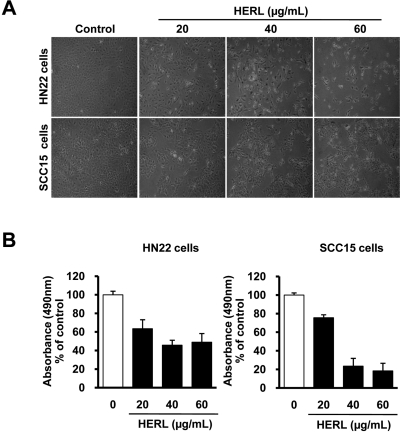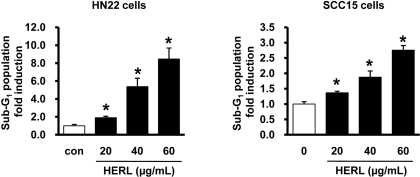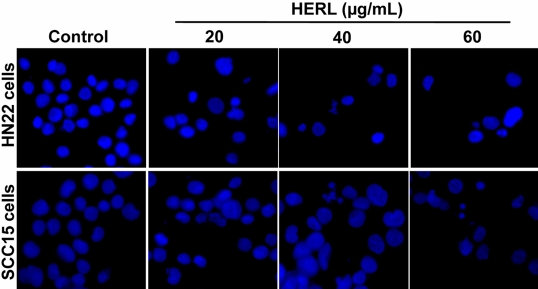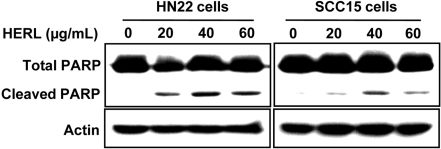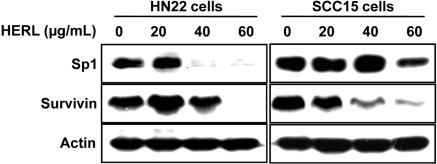Lab Anim Res.
2011 Mar;27(1):19-24. 10.5625/lar.2011.27.1.19.
The Apoptotic Effect of the Hexane Extract of Rheum undulatum L. in Oral Cancer Cells through the Down-regulation of Specificity Protein 1 and Survivin
- Affiliations
-
- 1Department of Oral Pathology, School of Dentistry and Institute of Oral Bioscience, Brain Korea 21 Chonbuk National University, Jeonju, Republic of Korea. efiwdsc@chonbuk.ac.kr
- 2Department of Preventive Dentistry, School of Dentistry and Institute of Oral Bioscience, Brain Korea 21, Chonbuk National University, Jeonju, Republic of Korea.
- KMID: 2391853
- DOI: http://doi.org/10.5625/lar.2011.27.1.19
Abstract
- The hexane extract of Rheum undulatum L. (HERL) has been shown to have anti-cancer activity in several cancers in vivo and in vitro. However, the anti-cancer activity of HERL and its molecular mechanism in human oral cancer cells has not been explored. Thus, the aim of this study was to elucidate the growth-inhibitory and apoptosis-inducing effects of HERL in HN22 and SCC15 oral cancer cell lines. This study shows that HERL inhibits oral cancer growth, decreases cell viability, and causes apoptotic cell death in HN22 and SCC15 cells, as characterized by morphological changes, nuclear condensation and fragmentation, the cleavage of PARP and the accumulation of cells in the sub-G1 phase. The treatment of oral cancer cells with HERL also resulted in decreased expression of specificity protein (Sp1) and its downstream protein, survivin. Therefore, our results suggest that the regulation of Sp1 and survivin plays a critical role in HERL-induced apoptosis in human oral cancer cells.
Keyword
MeSH Terms
Figure
Reference
-
1. Abdelrahim M, Baker CM, Abbruzzese JL, Safe S. Tolfenamic acid and pancreatic cancer growth, angiogenesis, and Sp protein degradation. J Natl Cancer Inst. 2006; 98:855–868. PMID: 16788159.
Article2. Cha TL, Qiu L, Chen CT, Wen Y, Hung MC. Emodin down-regulates androgen receptor and inhibits prostate cancer cell growth. Cancer Res. 2005; 65:2287–2295. PMID: 15781642.
Article3. Chang CH, Lin CC, Yang JJ, Namba T, Hattori M. Anti-inflammatory effects of emodin from ventilago leiocarpa. Am J Chin Med. 1996; 24:139–142. PMID: 8874670.
Article4. Chiefari E, Brunetti A, Arturi F, Bidart JM, Russo D, Schlumberger M, Filetti S. Increased expression of AP2 and Sp1 transcription factors in human thyroid tumors: a role in NIS expression regulation? BMC Cancer. 2002; 2:35. PMID: 12475396.
Article5. Dorsey JF, Kao GD. Aloe(-emodin) for cancer? More than just a comforting salve. Cancer Biol Ther. 2007; 6:89–90. PMID: 17297301.
Article6. Hamakawa H, Nakashiro K, Sumida T, Shintani S, Myers JN, Takes RP, Rinaldo A, Ferlito A. Basic evidence of molecular targeted therapy for oral cancer and salivary gland cancer. Head Neck. 2008; 30:800–809. PMID: 18429007.
Article7. He ZH, He MF, Ma SC, But PP. Anti-angiogenic effects of rhubarb and its anthraquinone derivatives. J Ethnopharmacol. 2009; 121:313–317. PMID: 19061946.
Article8. Hosoi Y, Watanabe T, Nakagawa K, Matsumoto Y, Enomoto A, Morita A, Nagawa H, Suzuki N. Up-regulation of DNA-dependent protein kinase activity and Sp1 in colorectal cancer. Int J Oncol. 2004; 25:461–468. PMID: 15254745.
Article9. Huang Q, Shen HM, Shui G, Wenk MR, Ong CN. Emodin inhibits tumor cell adhesion through disruption of the membrane lipid Raft-associated integrin signaling pathway. Cancer Res. 2006; 66:5807–5815. PMID: 16740720.
Article10. Huang Q, Lu G, Shen HM, Chung MC, Ong CN. Anti-cancer properties of anthraquinones from rhubarb. Med Res Rev. 2007; 27:609–630. PMID: 17022020.
Article11. Kang SC, Lee CM, Choung ES, Bak JP, Bae JJ, Yoo HS, Kwak JH, Zee OP. Anti-proliferative effects of estrogen receptor-modulating compounds isolated from Rheum palmatum. Arch Pharm Res. 2008; 31:722–726. PMID: 18563353.
Article12. Kavurma MM, Santiago FS, Bonfoco E, Khachigian LM. Sp1 phosphorylation regulates apoptosis via extracellular FasL-Fas engagement. J Biol Chem. 2001; 276(7):4964–4971. PMID: 11053446.
Article13. Kim JE, Kim HJ, Pandit S, Chang KW, Jeon JG. Inhibitory effect of a bioactivity-guided fraction from Rheum undulatum on the acid production of Streptococcus mutans biofilms at sub-MIC levels. Fitoterapia. 2010; e-published.
Article14. Kuo YC, Meng HC, Tsai WJ. Regulation of cell proliferation, inflammatory cytokine production and calcium mobilization in primary human T lymphocytes by emodin from Polygonum hypoleucum Ohwi. Inflamm Res. 2001; 50:73–82. PMID: 11289657.
Article15. Li F, Altieri DC. Transcriptional analysis of human survivin gene expression. Biochem J. 1999; 344(Pt 2):305–311. PMID: 10567210.
Article16. Li Y, Xie M, Yang J, Yang D, Deng R, Wan Y, Yan B. The expression of antiapoptotic protein survivin is transcriptionally upregulated by DEC1 primarily through multiple sp1 binding sites in the proximal promoter. Oncogene. 2006; 25:3296–3306. PMID: 16462771.
Article17. Lou Z, O'Reilly S, Liang H, Maher VM, Sleight SD, McCormick JJ. Down-regulation of overexpressed sp1 protein in human fibrosarcoma cell lines inhibits tumor formation. Cancer Res. 2005; 65(3):1007–1017. PMID: 15705902.18. Lu S, Archer MC. Sp1 coordinately regulates de novo lipogenesis and proliferation in cancer cells. Int J Cancer. 2010; 126(2):416–425. PMID: 19621387.19. Papineni S, Chintharlapalli S, Abdelrahim M, Lee SO, Burghardt R, Abudayyeh A, Baker C, Herrera L, Safe S. Tolfenamic acid inhibits esophageal cancer through repression of specificity proteins and c-Met. Carcinogenesis. 2009; 30(7):1193–1201. PMID: 19406933.
Article20. Parkin DM, Bray F, Ferlay J, Pisani P. Global cancer statistics, 2002. CA Cancer J Clin. 2005; 55:74–108. PMID: 15761078.
Article21. Safe S, Abdelrahim M. Sp transcription factor family and its role in cancer. Eur J Cancer. 2005; 41(16):2438–2448. PMID: 16209919.
Article22. Scully C, Bagan JV. Recent advances in oral oncology 2008; squamous cell carcinoma imaging, treatment, prognostication and treatment outcomes. Oral Oncol. 2009; 45:e25–e30. PMID: 19249236.
Article23. Shim JH, Shin JA, Jung JY, Choi KH, Choi ES, Cho NP, Kong G, Ryu MH, Chae JI, Cho SD. Chemopreventive effect of tolfenamic aicd on KB human cervical cancer cells and tumor xenograft by down regulating specificity protein 1. Eur J Cancer Prev. 2010; e-published.24. Shin JA, Shim JH, Jeon JG, Choi KH, Choi ES, Cho NP, Cho SD. Apoptotic effect of Polygonum Cuspidatum in oral cancer cells through the regulation of specificity protein 1. Oral Dis. 2010; e-published.
Article25. Stewart JR, Artime MC, O'Brian CA. Resveratrol: a candidate nutritional substance for prostate cancer prevention. J Nutr. 2003; 133(7):2440S–2443S. PMID: 12840221.
Article26. Sun Y, Giacalone NJ, Lu B. Terameprocol (Tetra-O-Methyl Nordihydroguaiaretic Acid), an Inhibitor of Sp1-Mediated Survivin Transcription, Induces Radiosensitization in Non-small Cell Lung Carcinoma. J Thorac Oncol. 2011; 6(1):8–14. PMID: 21107289.
Article27. Wang L, Wei D, Huang S, Peng Z, Le X, Wu TT, Yao J, Ajani J, Xie K. Transcription factor Sp1 expression is a significant predictor of survival in human gastric cancer. Clin Cancer Res. 2003; 9(17):6371–6380. PMID: 14695137.28. Wu J, Ling X, Pan D, Apontes P, Song L, Liang P, Altieri DC, Beerman T, Li F. Molecular mechanism of inhibition of survivin transcription by the GC-rich sequence-selective DNA binding antitumor agent, hedamycin: evidence of survivin down-regulation associated with drug sensitivity. J Biol Chem. 2005; 280:9745–9751. PMID: 15637054.29. Yao JC, Wang L, Wei D, Gong W, Hassan M, Wu TT, Mansfield P, Ajani J, Xie K. Association between expression of transcription factor Sp1 and increased vascular endothelial growth factor expression, advanced stage, and poor survival in patients with resected gastric cancer. Clin Cancer Res. 2004; 10:4109–4117. PMID: 15217947.
Article30. Yu HM, Liu YF, Cheng YF, Hu LK, Hou M. Effects of rhubarb extract on radiation induced lung toxicity via decreasing transforming growth factor-beta-1 and interleukin-6 in lung cancer patients treated with radiotherapy. Lung Cancer. 2008; 59:219–226. PMID: 17870203.
Article31. Zannetti A, Del Vecchio S, Carriero MV, Fonti R, Franco P, Botti G, D'Aiuto G, Stoppelli MP, Salvatore M. Coordinate up-regulation of Sp1 DNA-binding activity and urokinase receptor expression in breast carcinoma. Cancer Res. 2000; 60:1546–1551. PMID: 10749121.
- Full Text Links
- Actions
-
Cited
- CITED
-
- Close
- Share
- Similar articles
-
- Anti-Apoptotic Effect of Rheum undulatum Water Extract in Pancreatic beta-cell Line, HIT-T15
- Synergistic Effect of Sulindac and Simvastatin on Apoptosis in Lung Cancer A549 Cells through AKT-Dependent Downregulation of Survivin
- Antichemosensitizing effect of resveratrol in cotreatment with oxaliplatin in HCT116 colon cancer cell
- Urinary Survivin Test Compared to the Nuclear Matrix Protein (NMP)-22 Test and Urine Cytology for the Diagnosis of Bladder Cancer
- The Changes of Expression of Survivin by Butyrate in HCT116 Colon Cancer Cells

